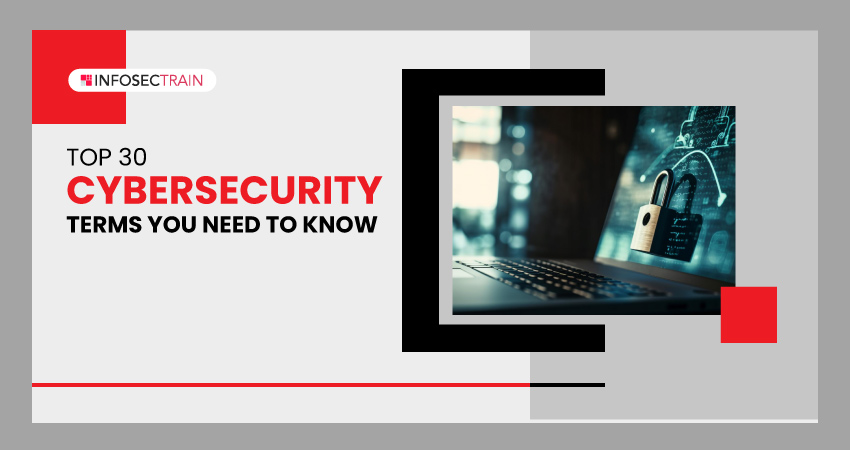Top 30 Cybersecurity Terms You Need to Know
In our rapidly evolving digital landscape and the alarming rise in cybercrimes, the cybersecurity domain has emerged as a critical pillar of our digital world. From multinational enterprises to individuals, the relentless march of cyber threats impacts everyone. Even the most resilient and technologically sophisticated entities can be vulnerable to the risks of cyber-attacks. Such incidents can lead to severe repercussions, encompassing financial setbacks, exposure of sensitive information, and disruption of critical services. In this landscape, it is imperative for individuals, businesses, and organizations to acknowledge the importance of cybersecurity and gain a firm understanding of the foundational terminology and concepts integral to this domain. This knowledge will help protect against the ever-changing threat landscape.

In this article, we have compiled a list of the most critical cybersecurity terms that will assist you in understanding the intricate cybersecurity environment. These terms and concepts will empower you to enhance your understanding and safeguard against cyber threats.
Top 30 Cybersecurity Terms to Know in 2024
Below are the top cybersecurity terms to know.
- Access Control: Controls permissions to ensure that only authorized individuals can access resources or data, enhancing security and data protection.
- Authentication: Authentication refers to verifying a user’s identity to access a system, often involving passwords, biometrics, or multi-factor authentication.
- Advanced Persistent Threat (APT): APT is a sophisticated, long-term cyberattack by skilled adversaries that aims to maintain stealth and persistence.
- Attack Vector: An attack vector refers to the path or method attackers use to breach a system’s security, such as phishing emails or software vulnerabilities.
- Backdoor: Backdoor is a secret entry point in a system, often created by attackers to bypass normal authentication and gain unauthorized access.
- Botnet: Botnet is a group of compromised devices controlled by cybercriminals for malicious purposes.
- Cryptography: Cryptography involves safeguarding communication and data using codes and ciphers to ensure security.
- Data Breach: Unauthorized access or disclosure of sensitive information, potentially leading to data theft or exposure.
- Dark Web: The Dark Web denotes the hidden segment of the internet, inaccessible to search engines, often used for illicit activities and maintaining anonymity.
- Data Loss Prevention (DLP): Strategies and tools to prevent unauthorized access and transmission of sensitive data.
- Denial of Service (DoS): DoS is an attack that overwhelms a system with traffic, causing it to become unavailable.
- Encryption: Encryption involves transforming data into a code to prevent unwanted access.
- Endpoint: A device, such as a computer or smartphone, that connects to a network and can be a potential target for cyberattacks.
- Exploit: An exploit is a malicious code or technique used to take advantage of vulnerabilities and gain unauthorized access or control over a system.
- Firewall: A firewall functions as a security mechanism that oversees and filters inbound and outbound network traffic, ensuring that only authorized data is permitted to traverse the network.
- Intrusion Detection System (IDS): An IDS monitors the network for suspicious activity and generates alerts when potential cyber threats or breaches are detected.
- Intrusion Prevention System (IPS): IPS not only detects but also actively blocks malicious activities, preventing potential security breaches.
- Incident Response Plan: An IRP is a documented procedure outlining how to react to and recover from a cybersecurity threat.
- Insider Threat: Insider threat is a security risk that arises from within an organization, involving individuals who are part of the organization, such as employees or vendors.
- Malware: Malware is malicious software designed to penetrate, damage, or steal valuable information from a computer system.
- Patch: Software updates contain patches for previously discovered vulnerabilities or bugs, which enhance system security.
- Privilege Escalation: Unauthorized elevation of user or system privileges to gain greater control and access within a network or system.
- Penetration Testing: Penetration testing or ethical hacking is used to identify vulnerabilities in a system or network.
- Phishing: Phishing is a cunning tactic used by cybercriminals to deceive people into revealing sensitive data or information, typically through fraudulent emails or websites.
- Ransomware: Ransomware constitutes a type of malware that encrypts a target’s data and then demands a ransom in exchange for its release.
- SOC (Security Operations Center): SOC is a centralized unit responsible for overseeing and addressing security incidents.
- Social Engineering: Manipulating people into disclosing sensitive or confidential information or performing actions compromising security.
- Spoofing: Faking or impersonating a source to deceive systems or users, such as IP or email spoofing, to hide true identities.
- Vulnerability: Weaknesses in a system that cybercriminals could exploit.
- Zero-Day Vulnerability: Zero-day vulnerability is a security flaw that hackers exploit before the software’s developer becomes aware of it.
These terms form the foundation of cybersecurity knowledge, and understanding them is crucial to staying safe in the digital era. By familiarizing yourself with these terms, you will be better equipped to defend your organization’s and personal data from digital threats. Continuous learning and heightened cybersecurity awareness ensure adaptability to evolving digital threats and bolster overall resilience in safeguarding information assets.
Feel free to explore other blogs related to cybersecurity
- Career Path For Cybersecurity
- Top Reasons to Explore a Career in Cybersecurity
- Top Tools Covered in Cybersecurity Expert Training Course
- Introduction to Cybersecurity Framework
- Defensive Cybersecurity Approach for Organizations
- Becoming a Cybersecurity Professional without a Tech Degree
How can InfosecTrain Help?
Whether you are an expert in cybersecurity or an everyday internet user, having a solid understanding of cybersecurity principles is essential for making informed decisions and ensuring your online safety. In our modern and technologically advanced society, it is of utmost importance to stay vigilant and prioritize cybersecurity.
At InfosecTrain, we provide expert-led Cybersecurity training courses, empowering individuals with the skills needed to safeguard their digital presence and navigate the digital landscape securely.




 1800-843-7890 (India)
1800-843-7890 (India) 
